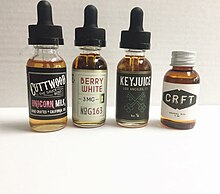The aerosol of electronic cigarettes is generated when the e-liquid reaches a temperature of roughly 100–250 °C within a chamber. The user inhales the aerosol, commonly called vapor, rather than cigarette smoke.The aerosol provides a flavor and feel similar to tobacco smoking. In physics, a vapor is a substance in the gas phase whereas an aerosol is a suspension of tiny particles of liquid, solid or both within a gas. The aerosol is made-up of liquid sub-micron particles of condensed vapor which mostly consist of propylene glycol, glycerol, water, flavorings, nicotine, and other chemicals. The various chemicals in the aerosol give rise to many issues concerning the safety of electronic cigarettes that have been much discussed. After a puff, inhalation of the aerosol travels from the device into the mouth and lungs. A 2014 review found that the particles emitted by e-cigarettes are comparable in size and number to particles in cigarette smoke, with the majority of them in the ultrafine range. The particles are of the ultrafine size which can go deep in the lungs and then into the systemic circulation. A 2014 review said local pulmonary toxicity may occur because metal nanoparticles can deposit in the lungs. Others show that the quantities of metals emitted are minimal and permissible by medicinal standards.
After the aerosol is inhaled, it is exhaled. Emissions from electronic cigarettes are not comparable to environmental pollution or cigarette smoke as their nature and chemical composition are completely different. The particles are larger, with the mean size being 600 nm in inhaled aerosol and 300 nm in exhaled vapor. Bystanders are exposed to these particles from exhaled e-cigarette vapor. There is a concern that some of the mainstream vapor exhaled by e-cigarette users can be inhaled by bystanders, particularly indoors, and have significant adverse effects. Since e-cigarettes involve an aerosolization process, it is suggested that no meaningful amounts of carbon monoxide are emitted. Thus, cardiocirculatory effects caused by carbon monoxide are not likely. E-cigarette use by a parent might lead to inadvertent health risks to offspring. E-cigarettes pose many safety concerns to children.For example, indoor surfaces can accumulate nicotine where e-cigarettes were used, which may be inhaled by children, particularly youngsters, long after they were used.
E-liquid is the mixture used in vapor products such as electronic cigarettes. The main ingredients in the e-liquid usually are propylene glycol, glycerin, nicotine, and flavorings. However, there are e-liquids sold without propylene glycol, nicotine, or flavors.The liquid typically contains 95% propylene glycol and glycerin.The flavorings may be natural or artificial. About 8,000 flavors exist as of 2014. There are many e-liquids manufacturers in the USA and worldwide.] While there are currently no US Food and Drug Administration (FDA) manufacturing standards for e-liquid, the FDA has proposed regulations that are expected to be finalized in late 2015. Industry standards have been created and published by the American E-liquid Manufacturing Standards Association (AEMSA).
Composition
Aerosol
The vapor usually contains nicotine, glycerin, propylene glycol, flavors and aroma transporters. The nicotine levels in the vapor varies either from puff-to-puff or among products of the same company A 2015 report commissioned by Public Health England concluded that e-cigarettes "release negligible levels of nicotine into ambient air". E-cigarettes without nicotine are also available. The vapor may also contain tiny amounts of toxicants, carcinogens, and heavy metals.Contamination with various chemicals has been identified.E-cigarette makers do not fully disclose information on the chemicals that can be released or synthesized during use. The metals have been found in trace amounts in the vapor, some of them at higher amounts than in cigarette smoke. The peak concentration of nicotine delivered by e-cigarette use is comparable to that produced by conventional cigarette smoking.
E-liquid
E-liquid, e-fluid, or e-juice is the mixture used in vapor products including e-cigarettes. E-Liquids come in many variations, including different nicotine strengths and many different flavors. The main ingredients are propylene glycol, glycerin, and flavorings; and most often, nicotine in liquid form. The liquid typically contains 95% propylene glycol and glycerin, and the remaining 5% being flavorings and nicotine. E-liquid can be made with or without nicotine, with >90% of e-liquids containing some level of nicotine. The most regularly used base carrier chemical is propylene glycol with or without glycerinE-liquid containing glycerin and water made without propylene glycol are also sold.It is uncertain whether the nicotine used in e-liquid is manufactured using a United States Pharmacopeia (USP) grade nicotine, a tobacco plant extract, tobacco dust or a synthetic nicotine. Most e-cigarette liquids contain nicotine, but the level of nicotine varies depending on user-preference and manufacturers. Although some e-juice is nicotine-free, surveys demonstrate that 97% of responders use products that contain nicotine. A 2015 review suggests that 1% of users use liquid without nicotine.




You can buy electronic cigarette at vapesourcing.com. vapesourcing offers high quality electronic marlboro kinds plus their own accessories, at discount rates. If a person are organizing to create a majority purchases, getting coming from vapesourcing can give you excellent deals and also bring in significant savings. Visit: https://vapesourcing.com/eleaf-istick-qc-200w-with-melo-300.html
ReplyDelete